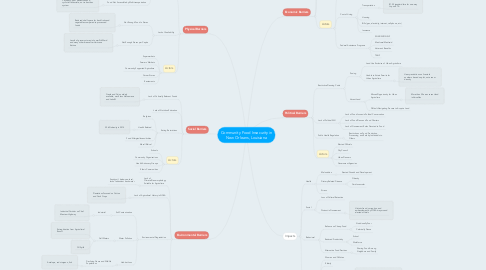
1. Physical Barriers
1.1. Lack of Infrastructure
1.1.1. Long Distances Between People and Food
1.1.1.1. In Versailles, closest full-service grocery store is 5 miles away.
1.1.2. Food Not Accessible by Multi-transportation
1.1.2.1. Car-heavy; poor pedestrian and cyclist infrastructure; not robust bus system
1.2. Lack of Availability
1.2.1. Not Enough Food in Stores
1.2.1.1. Reduced shelf space for fresh fruits and vegetables compared to processed foods
1.2.2. Not Enough Stores per Capita
1.2.2.1. Less # of grocery stores in Lower 9th Ward and many other areas after Hurricane Katrina
1.3. Actors
1.3.1. Supermarkets
1.3.2. Farmers' Markets
1.3.3. Community Supported Agriculture
1.3.4. Corner Stores
1.3.5. Restaurants
2. Social Barriers
2.1. Lack of Culturally Relevant Foods
2.1.1. Creole and Cajun widely available; much less Vietnamese and Latin@
2.2. Lack of Nutrition Education
2.3. Eating Restrictions
2.3.1. Religious
2.3.2. Health Related
2.3.2.1. 32.6% obesity in 2014
2.3.3. Food Allergies/Insensitivities
2.3.4. Moral/Ethical
2.4. Actors
2.4.1. Schools
2.4.2. Community Organizations
2.4.3. Health Advocacy Groups
2.4.4. Ethnic Communities
3. Economic Barriers
3.1. High Cost of Food
3.2. Competing Needs to Use Income Other Than Food
3.2.1. Rent, transportation, education, bills, insurance, etc...
3.3. Actors
3.3.1. Employers/Salary
3.3.2. Cost of Living
3.3.2.1. Transportation
3.3.2.1.1. $1.25 standard fare for one-way trip on RTA
3.3.2.2. Housing
3.3.2.3. Bills (gas, electricity, internet, cell phone, etc)
3.3.2.4. Insurance
3.3.3. Federal Assistance Programs
3.3.3.1. SNAP/WIC/NSLP
3.3.3.2. Medicare/Medicaid
3.3.3.3. Veteran's Benefits
3.3.3.4. TANF
4. Political Barriers
4.1. Restrictive Planning Code
4.1.1. Zoning
4.1.1.1. Land Use Exclusive of Urban Agriculture
4.1.1.2. Unable to Attain Permits for Urban Agriculture
4.1.1.2.1. Heavy restrictions on livestock numbers based on plot, not area or density
4.1.2. Vacant Land
4.1.2.1. Missed Opportunity for Urban Agriculture
4.1.2.1.1. More than 30 acres vacant land in Versailles
4.1.2.2. Difficult Navigating Process to Acquire Land
4.2. Lack of Political Will
4.2.1. Lack of Food Issues in Political Conversation
4.2.2. Lack of Food Plans and Food Charters
4.2.3. Lack of Government Roles Devoted to Food
4.3. Public Health Regulation
4.3.1. Restrictions on Food Production, Processing, and Sale by Individuals to Others
4.4. Actors
4.4.1. Elected Officials
4.4.2. City Council
4.4.3. Urban Planners
4.4.4. Government Agencies
5. Impacts
5.1. Health
5.1.1. Malnutrition
5.1.1.1. Stunted Growth and Development
5.1.2. Dietary Related Disease
5.1.2.1. Obesity
5.1.2.2. Cardiovascular
5.1.3. Stress
5.2. Social
5.2.1. Loss of Cultural Retention
5.2.2. Distrust in Government
5.2.2.1. Historic fraud, corruption, and embezzlement by NOLA mayors and elected officials
5.3. Behavioral
5.3.1. Reliance on Cheap Food
5.3.1.1. Nutritionally Poor
5.3.1.2. Calorically Dense
5.3.2. Reduced Productivity
5.3.2.1. School
5.3.2.2. Workforce
5.3.3. Alternative Food Practices
5.3.3.1. Sharing Food Among Neighbors and Family
5.4. Actors
5.4.1. Women and Children
5.4.2. Elderly
5.4.3. Minorities (ethnic, racial, religious, etc)
5.4.3.1. Vietnamese-Americans in Village de l'Est
5.4.4. Electorate
5.4.5. Low-income
5.4.5.1. 1/4th of NOLA live in poverty
6. Environmental Barriers
6.1. Lack of Climate/Geomorphology Suitable for Agriculture
6.1.1. Sandy soil, below sea-level, lack of abundant fresh water
6.2. Lack of Agricultural History in NOLA
6.2.1. Plantations Focused on Cotton and Cash Crops
6.3. Environmental Degradation
6.3.1. Soil Contamination
6.3.1.1. Industrial
6.3.1.1.1. Industrial Corridor on Chef Menteur Highway
6.3.2. Water Pollution
6.3.2.1. Gulf Waters
6.3.2.1.1. Eutrophication from Agricultural Runoff
6.3.2.1.2. Oil Spills
6.3.3. Habitat Loss
6.3.3.1. Declining Game and Wildlife Populations
6.3.3.1.1. Antelope, red sturgeon, fish
6.4. Actors
6.4.1. Environmental Protection Agency
6.4.2. Industry
6.4.3. Upstream Mississippi Farms
6.4.4. Cooperative Extension/LSUAg
